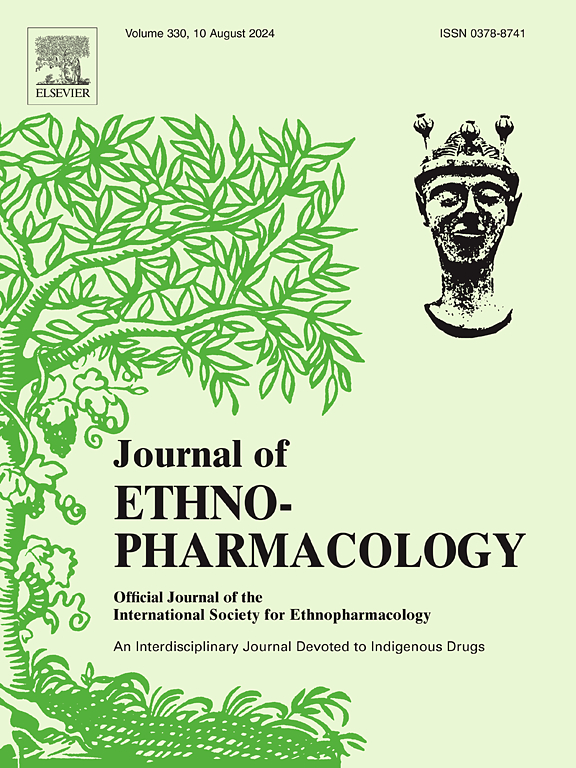沙棘调节bcg诱导肝炎PXR/CAR/NF-κB信号通路,恢复CYP2C代谢功能
IF 5.4
2区 医学
Q1 CHEMISTRY, MEDICINAL
引用次数: 0
摘要
民族药理学相关性:沙棘(Hippophae rhamnoides L.)具有抗氧化、抗动脉粥样硬化、抗炎症、抗癌和肝脏保护作用;并可抑制ECM胶原沉积,减轻肝纤维化。因此,我们推测沙棘颗粒多糖可能具有抗肝炎活性。研究目的:探讨沙棘对bcg诱导肝损伤后肝孕激素X受体(PXR)/组成型雄烷受体(CAR)/NF-κB信号转导及CYP2C的调节作用。材料与方法通过单尾静脉注射卡介苗建立小鼠肝损伤模型。ig给药7 d。16 α -碳腈孕烯醇酮(PCN, PXR激动剂)和1,4-二-(2-[3,5-二氯吡啶氧基])苯(TCPOBOP, CAR激动剂)作为阳性对照。为了评估模型的成功与否,测量了血清丙氨酸转氨酶(ALT)和天冬氨酸转移酶(AST)水平以及肝脏IL-1β、TNF-α、11,12-环氧二碳三烯酸(EET)和14,15-EET的表达。结果共鉴定出5281种可靠的蛋白,包括43种细胞色素P450 (CYP)亚型,其中CYP2C亚家族约占27%。bcg诱导肝炎下调23个CYPs。BCG组炎症浸润增加,ALT/AST水平升高。PXR、CAR、CYP2C、11,12- eet和14,15- eet下调,而NF-κB、IL-1β和TNF-α上调。服用SG后,肝脏炎症和ALT/AST水平降低;PXR、CAR、CYP2C、11,12- eet、14,15- eet升高,NF-κB、IL-1β、TNF-α降低。SG高剂量组效应与PCN和TCPOBOP组效应相当。结论ssgs可能调节PXR/CAR/NF-κB信号通路和CYP重编程,减轻bcg诱导的肝损伤和炎症。本文章由计算机程序翻译,如有差异,请以英文原文为准。

Sea buckthorn regulates PXR/CAR/NF-κB signaling and restores CYP2C metabolic function in BCG-induced hepatitis
Ethnopharmacological relevance: Sea buckthorn (Hippophae rhamnoides L.) exhibits anti-oxidation, anti-atherosclerosis, anti-inflammation, anti-cancer, and liver protective effects; it may also inhibit ECM collagen deposition and alleviate liver fibrosis. Therefore, we hypothesized that sea buckthorn granule (SG) polysaccharides may possess anti-hepatitis activity.
Aim of the study: To investigate the role of sea buckthorn in regulating hepatic pregnane X receptor (PXR)/constitutive androstane receptor (CAR)/NF-κB signal transduction and CYP2C following BCG-induced liver injury.
Materials and methods
A mouse liver injury model was established through single tail vein injection of Bacillus Calmette–Guérin (BCG) vaccine. SGs were administrated intragastrically for 7 days. Pregnenolone 16alpha-carbonitrile (PCN, PXR agonists) and 1,4-bis-(2-[3,5-dichloropyridyloxy]) benzene (TCPOBOP, CAR agonists) were administered as positive controls. To evaluate modeling success, serum alanine aminotransferase (ALT) and aspartate transferase (AST) levels and hepatic IL-1β, TNF-α, 11,12-epoxyeicosatrienoic acid (EET), and 14,15-EET expressions were measured.
Results
Overall, 5281 reliable proteins were identified, including 43 cytochrome P450 (CYP) subtypes, with the CYP2C subfamily accounting for approximately 27 %. BCG-induced hepatitis downregulated 23 CYPs. The BCG group exhibited increased inflammatory infiltration and ALT/AST levels. PXR, CAR, CYP2C, 11,12-EET, and 14,15-EET were downregulated, whereas NF-κB, IL-1β, and TNF-α were upregulated. Following SG administration, hepatic inflammation and ALT/AST levels decreased; PXR, CAR, CYP2C, 11,12-EET, and 14,15-EET increased, and NF-κB, IL-1β, and TNF-α decreased. The SG high-dose group effects were comparable to the PCN and TCPOBOP group effects.
Conclusions
SGs may regulate the PXR/CAR/NF-κB signaling pathway and CYP reprogramming, mitigating BCG-induced liver injury and inflammation.
求助全文
通过发布文献求助,成功后即可免费获取论文全文。
去求助
来源期刊

Journal of ethnopharmacology
医学-全科医学与补充医学
CiteScore
10.30
自引率
5.60%
发文量
967
审稿时长
77 days
期刊介绍:
The Journal of Ethnopharmacology is dedicated to the exchange of information and understandings about people''s use of plants, fungi, animals, microorganisms and minerals and their biological and pharmacological effects based on the principles established through international conventions. Early people confronted with illness and disease, discovered a wealth of useful therapeutic agents in the plant and animal kingdoms. The empirical knowledge of these medicinal substances and their toxic potential was passed on by oral tradition and sometimes recorded in herbals and other texts on materia medica. Many valuable drugs of today (e.g., atropine, ephedrine, tubocurarine, digoxin, reserpine) came into use through the study of indigenous remedies. Chemists continue to use plant-derived drugs (e.g., morphine, taxol, physostigmine, quinidine, emetine) as prototypes in their attempts to develop more effective and less toxic medicinals.
 求助内容:
求助内容: 应助结果提醒方式:
应助结果提醒方式:


